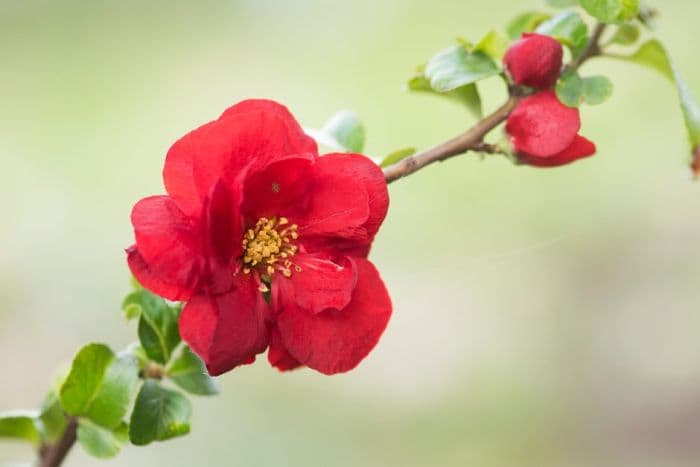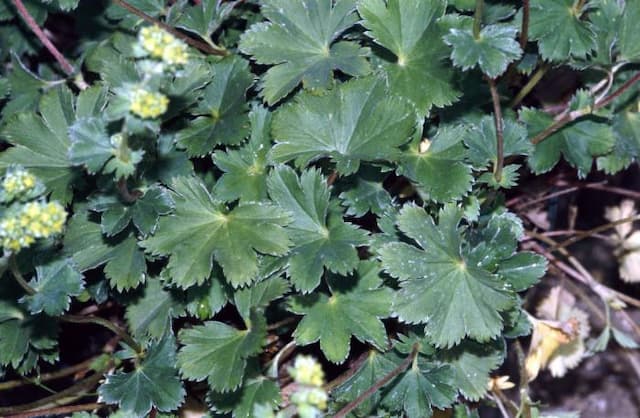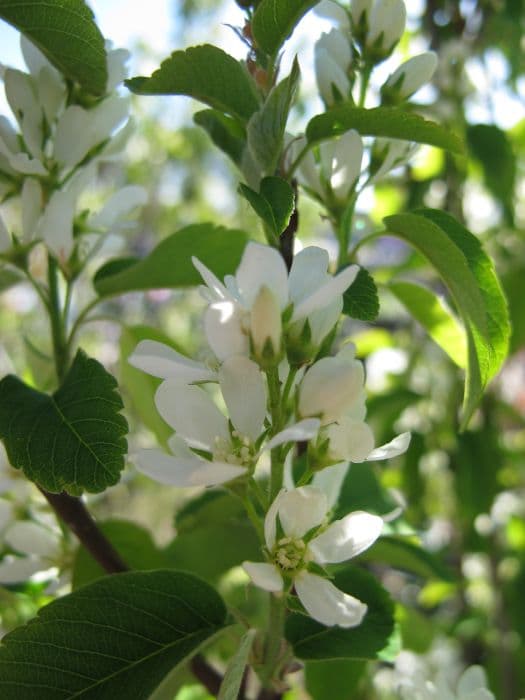Flowering Quince Chaenomeles speciosa 'Scarlet Storm' (PBR)

ABOUT
The Scarlet Storm is a highly ornamental plant known for its vibrant and showy flowers. This variety of flowering quince produces large, double blossoms that are a stunning deep scarlet red. The flowers boast numerous velvety petals that create a lush, ruffled effect as they cluster along the bare branches. This full and rich coloration makes it a standout during the blooming season, which typically occurs in the spring. The leaves of the Scarlet Storm emerge after the flowers, unfolding into a glossy green. These leaves are oval-shaped with a somewhat pointed tip, presenting a sharp contrast against the woody branches with their verdant color. Over time, the foliage may transition into a subtle but attractive autumnal color before dropping off at the end of the season. The overall form of the Scarlet Storm is bushy and dense, contributing to its use as a decorative plant in various landscape applications. Its branching habit gives it a sturdy look, with the branches themselves being quite robust. This plant can make a significant visual impact in gardens, either when planted as a single specimen or when used as part of a hedgerow or border due to its colorful and abundant flowering characters.
About this plant
 Names
NamesFamily
Rosaceae.
Synonyms
Flowering Quince, Japanese Quince, Japonica.
Common names
Chaenomeles speciosa 'Scarlet Storm' (PBR)
 Toxicity
ToxicityTo humans
Flowering quince is not commonly listed as toxic to humans. However, as with many ornamental plants, it is not intended for consumption, and eating large quantities of the plant, particularly the seeds, may cause stomach upset or discomfort due to mildly toxic compounds.
To pets
Flowering quince may also cause mild digestive upset in pets if ingested in significant quantities. The seeds inside the fruit can contain trace amounts of cyanide, as is common with many seeds in the Rosaceae family. If a pet consumes a large amount of seeds or plant material, symptoms could include vomiting or diarrhea. It is advisable to keep an eye on pets when they are near ornamental plants and to consult a veterinarian if there are signs of poisoning.
 Characteristics
CharacteristicsLife cycle
Perennials
Foliage type
Deciduous
Color of leaves
Green
Flower color
Red
Height
3-4 feet (0.91-1.22 meters)
Spread
4-5 feet (1.22-1.52 meters)
Plant type
Shrub
Hardiness zones
5
Native area
Asia
Benefits
 General Benefits
General Benefits- Ornamental Appeal: Vibrant double scarlet flowers provide a striking display in the landscape.
- Extended Blooming: Offers a long blooming period, typically from early spring to late spring.
- Attracts Wildlife: The blossoms attract pollinators such as bees and butterflies, promoting biodiversity.
- Low Maintenance: Once established, the flowering quince requires minimal care, making it ideal for busy gardeners.
- Drought Tolerance: It is relatively drought-resistant, which is beneficial in areas with water restrictions.
- Adaptable: This plant can thrive in a variety of soil types and environmental conditions.
- Hedge or Barrier Use: Can be used as a decorative hedge or a barrier due to its dense growth habit.
- Fall Interest: Leaves often turn to a lovely shade of yellow or red in the autumn, adding seasonal interest.
- Winter Hardiness: Capable of withstanding cold temperatures, making it suitable for gardens in cooler climates.
 Medical Properties
Medical Properties- Anti-inflammatory: Chaenomeles speciosa has been traditionally used in Chinese medicine to reduce inflammation.
- Analgesic: The plant may have pain-relieving properties.
- Antipyretic: It is used to reduce fever in traditional practices.
- Hepatoprotective: There has been some indication of liver-protecting effects.
- Immune system support: It might have a role in enhancing immune functions.
- Antioxidant: Compounds in the fruit are suggested to have antioxidant properties.
- Antimicrobial: It possesses potential antimicrobial activity against certain pathogens.
- Gastrointestinal aid: Used to help with digestion and relieve gastrointestinal discomfort.
- Cardiovascular benefits: There might be compounds that support cardiovascular health, though evidence is limited and not fully established.
- Antidiabetic effects: Some studies suggest a potential use in managing diabetes, but more research is necessary.
 Air-purifying Qualities
Air-purifying QualitiesThis plant is not specifically known for air purifying qualities.
 Other Uses
Other Uses- The flowering quince can be used as a natural dye, especially the bark, which can produce shades of pink or orange, depending on the mordant used.
- Chaenomeles branches are sturdy and can be used for crafting homemade wreaths or as a structural element in floral arrangements.
- Dried flowering quince fruit can be added to potpourri mixes for a natural fragrance and to enhance the visual appeal with its unique shape.
- The wood of the flowering quince is hard and can be carved into small objects or used as handle material for specialized tools.
- Flowering quince can be trained into bonsai forms, creating miniature landscapes for enthusiasts of the art form.
- The thorns of the flowering quince are sharp enough to be utilized as natural sewing needles in emergency situations.
- Ink can be extracted from the fruit of the flowering quince to create natural and unique pigments for art purposes.
- Fallen flowering quince petals can be used to line walkways or as a biodegradable confetti for outdoor celebrations.
- The dense growth habit of flowering quince can be exploited to create natural privacy screens or living fences in gardens.
- Flowering quince fruit can be used to infuse vinegar or alcohol, imparting a subtle fruity flavor to the liquids.
Interesting Facts
 Feng Shui
Feng ShuiThe Flowering Quince is not used in Feng Shui practice.
 Zodiac Sign Compitability
Zodiac Sign CompitabilityThe Flowering Quince is not used in astrology practice.
 Plant Symbolism
Plant Symbolism- Renewal: Chaenomeles speciosa, commonly known as flowering quince, often blooms in early spring, symbolizing the idea of new beginnings and the renewal of nature after winter.
- Good Fortune: In Asian cultures, particularly Chinese, flowering quince is associated with luck and prosperity, making it a popular plant during festivities.
- Love and Fertility: With its vibrant red flowers, the flowering quince is also a symbol of love and affection. It is sometimes related to fertility and abundance because of its prolific nature.
- Protection: Some traditions consider the thorny branches of the flowering quince as a symbol of protection against evil and harm.
 Water
WaterThe common name of Chaenomeles speciosa 'Scarlet Storm' (PBR) is Flowering Quince 'Scarlet Storm'. It should be watered deeply to encourage a strong root system, and the soil should be allowed to dry out somewhat between waterings. During the growing season, generally once a week is a good rule of thumb, but this may vary depending on climate conditions. On average, a newly planted Flowering Quince 'Scarlet Storm' may need approximately 1-2 gallons of water per week, but in very hot or windy conditions, more frequent watering might be necessary. In winter or during periods of rain, reduce the amount of water to avoid waterlogging the soil.
 Light
LightFlowering Quince 'Scarlet Storm' thrives in full sun to partial shade. The ideal spot is where it can receive at least 6 hours of direct sunlight per day. It's adaptable but performs best with steady morning sunlight and some afternoon shade in hotter regions, which prevents scorching.
 Temperature
TemperatureFlowering Quince 'Scarlet Storm' is hardy and can withstand a range of temperatures, surviving minimum temperatures down to around -20°F. The ideal growing temperatures for the plant are between 60°F and 80°F. Although Flowering Quince 'Scarlet Storm' is cold hardy, it's best to avoid exposure to prolonged temperatures at the extremes to ensure optimal growth and flowering.
 Pruning
PruningPruning the Flowering Quince 'Scarlet Storm' helps to maintain its shape, encourage new growth, and remove any damaged or diseased branches. The best time to prune is immediately after flowering to avoid cutting off next year's buds. Thinning out the center of the plant every few years encourages air circulation and light penetration, which can help reduce disease risks. Pruning can be done annually but should be kept to a minimum to avoid reducing the number of flowers.
 Cleaning
CleaningAs needed
 Soil
SoilFlowering quince 'Scarlet Storm' prefers well-draining, fertile loam with a pH of 6.0 to 7.0. An ideal mix would be two parts garden soil, one part well-rotted compost, and one part perlite or sand to improve drainage.
 Repotting
RepottingFlowering quince 'Scarlet Storm' generally does not require frequent repotting and should be repotted every 2 to 3 years, or when the plant has outgrown its current container.
 Humidity & Misting
Humidity & MistingFlowering quince 'Scarlet Storm' is tolerant of most humidity levels but prefers average to high humidity. It does not have specific humidity requirements and can adapt to outdoor conditions in most climates.
 Suitable locations
Suitable locationsIndoor
Place in bright, indirect light and ensure good air circulation.
Outdoor
Plant in sun to partial shade; shelter from strong winds.
Hardiness zone
5-9 USDA
 Life cycle
Life cycleChaenomeles speciosa 'Scarlet Storm', commonly known as Flowering Quince, begins its life cycle as a dormant seed that requires stratification to germinate. Upon sprouting, the seedling grows into a woody, deciduous shrub, developing a root system and foliage. Throughout the spring, the shrub produces vivid, double red flowers before the leaves fully unfurl. After pollination, it develops small, hard fruit that matures in the fall and can persist into winter. During autumn, the leaves turn yellow and drop as the plant enters dormancy. Each year, the Flowering Quince will follow this cycle, gradually growing larger and more mature with every season.
 Propogation
PropogationPropogation time
Spring-Early Summer
Propogation: The most popular method of propagating Flowering Quince 'Scarlet Storm', a patented variety of Chaenomeles speciosa, is through softwood cuttings. The ideal time to take cuttings is in late spring or early summer when new growth is still flexible. To propagate, cut a piece of the stem about 4 to 6 inches long with several leaves attached, just below a node where leaf buds are present. Remove the lower leaves to expose the nodes, which is where roots will form. Dip the cut end in rooting hormone powder to encourage root development and plant the cutting in a mix of peat and perlite, keeping the soil moist but not waterlogged. Provide a warm environment and consider covering with a plastic bag to maintain humidity. Within a few weeks, the cutting should root and can eventually be transplanted outdoors.









